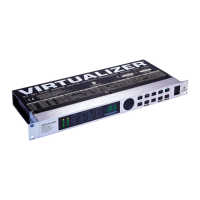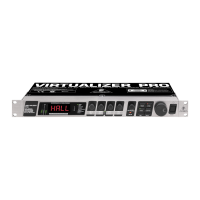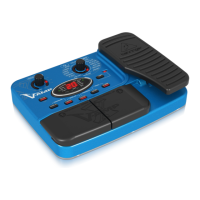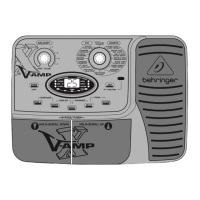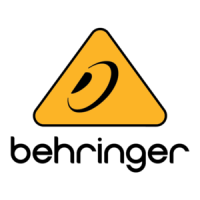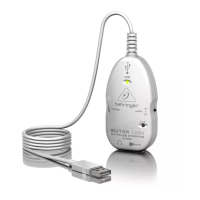DISTORTION/AMP
Distortion eects and amp simulations
VOCAL DISTORTION: This eect is very hip when used on vocals and drum loops,
and is combined with a delay and anger.
TUBE DISTORTION: This eect simulates the sound of dierent tube types.
Whenan analog tube, as found in a guitar amplier, is overamplied by raising
the input signal (e.g. of a guitar), the original signal is mixed with the harmonic
overtones. With rising overmodulation (also known as saturation of tubes),
theoriginal signal is distorted and the sound is fresh and full. This is a classic
sound in rock music.
GUITAR AMP: This eect simulates the sound characteristics of a complete guitar
amplier. You can connect a guitar or bass (after appropriate pre-amplication)
directly to the VIRTUALIZER 3D, and from there to a mixing console or
recordingdevice.
TRI FUZZ: This is a special guitar distortion type. Jimi Hendrix was one of the rst
guitarists to recognize the appeal of this broadband transistor overmodulation.
Thehumming distortion of the FUZZ BOX has again become popular with
alternative rock and grunge. The VIRTUALIZER 3D’s fuzz works in three dierent
frequency bands.
SPEAKER SIMULATION: The VIRTUALIZER 3D is able to simulate various types of
speakers. Typical guitar amplifying speakers as well as multimedia speakers are
available. You can also use a parametric equalizer to further rene the sound.
RING MODULATOR: This eect allows a radical alienation of audio signals.
Similar to the principle of FM radio, the signal is multiplied by a carrier frequency,
so that frequency modulation (FM) takes place. This eect is very well suited for
vocal alienation (robot voice).
LO-FI: For years, digital technique has been striving for high quality, lownoise,
andbrilliant sounds. In the recent past there have been increasing calls for a
return “tothe roots” to achieve the warmth of the old analog sounds. Thetechno/
dance group swears by vinyl and some music lovers miss the charm of good old
vinyl discs and tape machines. This trend is known as Lo-Fi (instead of Hi-Fi).
We have taken this tendency into account and included the relevant eect in
the FX2000. Your recordings sound like 8-bit audio, complete with noise and
humming like the old days! A true drum loop in TR808/TR909 style really gets
going when it sounds thick and dusty.
Parameter Function
Gain Volume
Distortion Distortion
Drive
Degree of tube distortion (Tube Distortion & Guitar Amp) /
distortion at the output circuitry (Tri Fuzz)
Type
Nature of vocal distortion (Vocal Distortion) / selection of eight
dierent loudspeakers
(Speaker Simulation)
Delay Length of delay
Delay Gain Degree of delay
Flanger Level Degree of anger
Flanger Speed Speed of anger
Pre HP Frequency of the in-series connected high pass lter
Pre LP Frequency of the in-series connected low pass lter
Tube Selection Selects between three tube types
Mid EQ Mid equalizer
In Gain Input gain
Low Fuzz Distortion of low frequencies
Mid Fuzz Distortion of mid frequencies
Hi Fuzz Distortion of high frequencies
Cabinet Type Selects between eight speaker types
Presence Presence
Hi Damp Damping of high frequency parts
EQ Gain Raising or lowering of EQ
EQ Frequency Frequency of EQ
EQ Q Q factor of EQ
Speed Speed of LFO
Depth Modulation depth
Carrier Frequency Modulation frequency
Mode
(Ring Modulator): LFO = The LFO modulates.
ENV=Modulation through envelope follower.
RAND = Modulation through random generator.
SINE = The input signal is replaced by a sine tone and modulated
by a random generator.
Slewing
Smoothing of modulation signal for RAND and SINE
(Ring Modulator)
Bit Resolution Resolution of D/A converter
Buzz Level Intensity of the buzz level
Noise Gain Volume of the noise
Noise HP Lower cut-o frequency of the noise
Noise LP Upper cut-o frequency of the noise
Damp Frequency of low pass lter after the tube stage (Tube Distortion)
Tone
High frequency attenuation of input signal
(Ring Modulator / LoFi)
Tab. 2.7: Parameter functions of distortion eects and amplication simulations
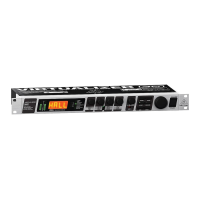
